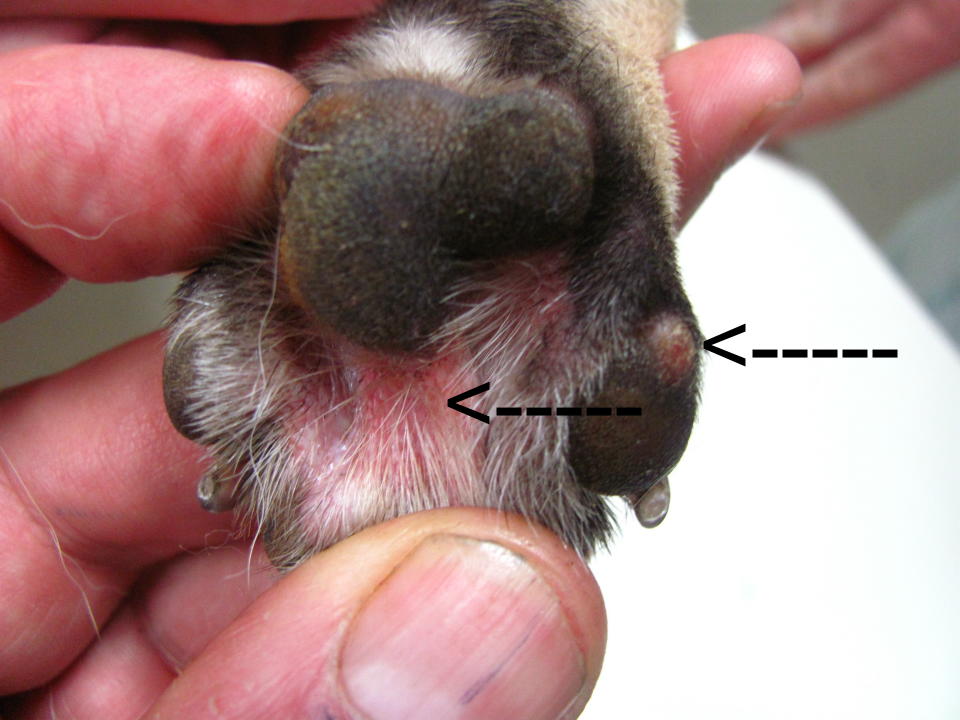Decoding Dog Paw Pad Color: Why Are They Sometimes Pink?

Ever gaze at your furry friend's paws and notice a rosy hue? Those cute pink pads on dogs paws can be quite the curiosity, sparking questions about their significance and potential health implications. Why are some dog paw pads pink, while others are black or brown? Is it a breed-specific trait, a sign of health, or something else entirely? Let's dive into the world of canine paw pads and unravel the mysteries surrounding their sometimes-pink pigmentation.
The color of a dog's paw pads can vary significantly, ranging from jet black to a soft, delicate pink. This variation is influenced by a number of factors, including genetics, age, and environmental factors. Understanding the nuances of paw pad pigmentation can provide valuable insights into a dog's overall health and well-being.
While genetics play a significant role in determining paw pad color, other factors can also contribute to a pink or light-colored appearance. Sun exposure, for instance, can cause fading of darker pigments, resulting in a lightening of the paw pads over time. Similarly, friction and wear and tear from walking on rough surfaces can lead to a gradual loss of pigmentation, making the pads appear pinker.
The importance of healthy paw pads cannot be overstated. These tough, yet sensitive, structures provide essential protection and cushioning for a dog's feet, enabling them to navigate various terrains with ease and comfort. They act as shock absorbers, provide insulation against extreme temperatures, and aid in traction. Maintaining the health of these pads is crucial for a dog's mobility and overall quality of life.
However, pink paw pads can sometimes be a sign of underlying health issues. Certain medical conditions, such as allergies, infections, and autoimmune disorders, can manifest as changes in paw pad pigmentation. It's crucial to monitor any changes in the appearance of your dog's paw pads and consult a veterinarian if you notice any redness, swelling, or other abnormalities.
Canine paw pad color is primarily determined by genetics. Just like human skin color, dog paw pad pigmentation is inherited from their parents. Breeds with lighter coats often have lighter-colored paw pads, including pink. Similarly, dogs with darker coats tend to have darker paw pads.
Proper paw pad care involves regular inspection, cleaning, and moisturizing. Check your dog's paws regularly for any cuts, abrasions, or foreign objects. Clean the paws with a damp cloth after walks to remove dirt and debris. Consider using a paw balm or moisturizer, especially during dry winter months, to prevent cracking and dryness.
Benefits of healthy paw pads include enhanced mobility, protection against injuries, and better grip on various surfaces. Healthy paw pads allow dogs to run, jump, and play without discomfort. They also provide a barrier against sharp objects, hot pavement, and icy surfaces. The rough texture of healthy paw pads enhances traction, preventing slips and falls.
Advantages and Disadvantages of Pink Paw Pads
| Advantages | Disadvantages |
|---|---|
| Can be aesthetically pleasing | More susceptible to sunburn and irritation |
It's important to note that having pink paw pads isn't inherently advantageous or disadvantageous. It's simply a variation in pigmentation. However, lighter-colored paw pads may be more susceptible to sunburn and irritation compared to darker paw pads.
Frequently Asked Questions:
1. Why are my dog's paw pads turning pink? Several factors can cause pink paw pads, including genetics, sun exposure, and wear and tear. Consult a veterinarian if you notice any sudden changes or accompanying symptoms.
2. Are pink paw pads a sign of a health problem? Not always. However, they can sometimes indicate underlying health issues, so it's important to monitor for any other changes and consult a vet if necessary.
3. How can I protect my dog's pink paw pads? Use paw balm, avoid hot pavement, and limit exposure to harsh chemicals.
4. Can dog paw pads change color over time? Yes, paw pad color can change due to various factors like sun exposure and aging.
5. What are some common paw pad problems? Dryness, cracking, cuts, burns, and infections are common paw pad problems.
6. How can I tell if my dog's paw pads are healthy? Healthy paw pads are typically smooth, free of cracks or cuts, and have a consistent color.
7. When should I take my dog to the vet for paw pad issues? Consult a veterinarian if you notice any redness, swelling, bleeding, discharge, or if your dog is licking their paws excessively.
8. Are certain dog breeds more prone to pink paw pads? Yes, breeds with lighter coats tend to have lighter-colored paw pads, including pink.
In conclusion, the intriguing world of dog paw pads reveals a fascinating interplay of genetics, environment, and health. While pink paw pads can be a charming characteristic, understanding the potential causes and implications of this pigmentation is essential for responsible pet ownership. By being attentive to changes in paw pad color and providing appropriate care, we can ensure our canine companions enjoy happy, healthy, and active lives. Remember to consult with your veterinarian if you have any concerns about your dog's paw pads, as they can provide tailored advice and address any underlying health issues. Taking proactive steps to maintain healthy paw pads will contribute significantly to your dog's overall well-being and allow them to explore the world comfortably on all fours.
Understanding tay savages alleged jail altercation
Unmasking john hannah actor roles and legacy
Transform your home with behr exterior dark paint colors









:max_bytes(150000):strip_icc()/GettyImages-1144580161-e70991a2415d46608aeb91e43acc3ad5.jpg)



